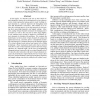Free Online Productivity Tools
i2Speak
i2Symbol
i2OCR
iTex2Img
iWeb2Print
iWeb2Shot
i2Type
iPdf2Split
iPdf2Merge
i2Bopomofo
i2Arabic
i2Style
i2Image
i2PDF
iLatex2Rtf
Sci2ools
NOCS
2008
IEEE
2008
IEEE
Adding Slow-Silent Virtual Channels for Low-Power On-Chip Networks
In this paper, we introduce the use of slow-silent virtual channels to reduce the switching power of on-chip networks while keeping the leakage power small. Adding virtual channels to a network improves the throughput until each link bandwidth is saturated. This enables us to reduce the switching power of on-chip networks by decreasing their operating frequency and supply voltage. However, adding virtual channels increases the leakage power of routers as well as the area due to their large buffers; so the runtime power gating is applied to individual virtual channels to eliminate this problem. We evaluate the performance of slow-silent virtual channels by using real application traces, and their power consumption (switching and leakage) is evaluated based on the detailed design of a virtual-channel router placed and routed with a 90nm technology. These evaluation results show that a network with three or four virtual channels achieves the best energy efficiency in a uniform traffic....
| Added | 01 Jun 2010 |
| Updated | 01 Jun 2010 |
| Type | Conference |
| Year | 2008 |
| Where | NOCS |
| Authors | Hiroki Matsutani, Michihiro Koibuchi, Daihan Wang, Hideharu Amano |
Comments (0)

